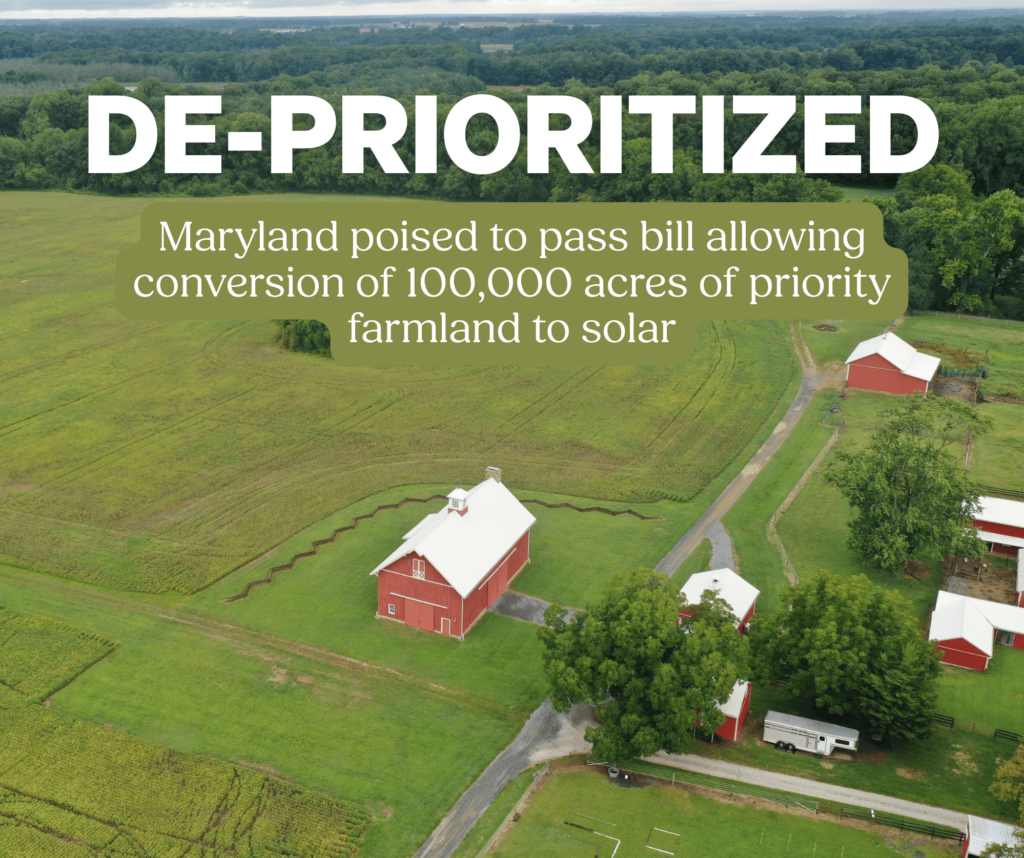Maryland’s General Assembly wraps up Monday and while the state’s budget shortfall dominated the session, energy legislation was also a constant issue. ESLC’s policy staff were active on both fronts, working to ensure the best possible conservation outcomes despite a difficult environment.
Given the magnitude of the budget shortfall, funding for conservation, including Program Open Space, was targeted for diversion to the state’s general coffers. A vocal and diverse statewide coalition rallied to defend conservation funding and was, to a large degree, successful. Farmland preservation funding took the biggest hit and is slated to see substantial cuts for the next four years, but the programs remain fundamentally intact for when budgets improve.
The Renewable Energy Certainty Act (SB931/HB1036), a bill introduced by both House and Senate Leadership, is aimed at faster development of solar projects to help achieve the state’s renewable energy goals. But the bill includes provisions that favor developers over farmers and local government. Strenuous objections from county, agricultural, and conservation advocates led to substantial revision and amendments, with mixed results.
As currently drafted, the bill does the following:
- Creates uniform standards for solar siting and design
- Increases the mandatory decommissioning bond to disassemble projects at the end of their life-cycle from 100% to 125% (less any salvage value)
- Establishes detailed setbacks and landscaping requirements for projects
- Makes explicit that solar projects comply with state laws re: stormwater management, erosion/sediment control, soil compaction and ground cover under the solar panels
- Prohibits large projects (above 5 MW) in designated Growth Areas (this condition would prevent situations like the solar development at Chestertown’s Clarke-Hopewell Farm)
- Prohibits removing topsoil from the project site
- Affirms local taxing authority over projects (previous versions exempted solar projects from personal and real property taxes by counties)
- Excludes pollinator habitat and apiary projects from the definition of “agrivoltaics”
- Exempts projects currently in the approval queue from the provisions of the bill
- Requires a comprehensive analysis of state-owned lands and their suitability for solar development
As proposed in the amended bill, local decision-making over solar projects in their jurisdiction would return to counties but only after 5% of lands in a county’s designated Priority Protection Areas were converted to solar.
ESLC joined with others to assert the impacts of this provision pose too high of a risk to future agricultural viability and advocated to lower the threshold of solar development to 2%. Eastern Shore Senators’ Hershey and Mautz introduced amendments to alter the Priority Preservation Area cap and Delegate Ghrist proposed multiple amendments on the House floor. Those amendments were not adopted. Furthermore, two Eastern Shore counties, Dorchester and Somerset, do not have state-recognized Priority Preservation Areas, which means there is no mechanism by which these counties could ever regain some level of autonomy over solar siting.
The Priority Preservation Area provision of SB931/HB1036 generated considerable debate within both the House and Senate this session and, as of this writing, appears on the verge of passing.
The tension between promoting solar energy and preserving farmland underscores the complex challenges facing policymakers as they work to meet the state’s energy goals without undermining its agricultural viability.
Despite the compromises made, unresolved issues like the cap on solar development in Priority Preservation Areas and the exclusion of certain counties from this framework remain critical points of contention. As Maryland moves forward, continued collaboration and careful consideration of both environmental and agricultural needs will be essential. One thing remains certain, there is still much work to be done to understand the economic impact to rural counties should more than 100,000 acres of key agricultural lands in Priority Preservation Areas be converted to commercial solar installations.
